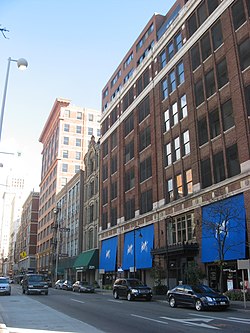United States historic place
| West Fourth Street Historic District | |
| U.S. National Register of Historic Places | |
| U.S. Historic district | |
| Cincinnati Local Historic Landmark | |
 Along Fourth Street in the district Along Fourth Street in the district | |
  | |
| Location | Cincinnati, Ohio |
|---|---|
| Area | 60 acres (240,000 m) |
| Architect | Samuel Hannaford |
| Architectural style | Italianate and Renaissance |
| NRHP reference No. | 76001443, 79001861 (amendment) |
| Added to NRHP | August 13, 1976 August 13, 1979 (amendment) |
West Fourth Street Historic District is a registered historic district in downtown Cincinnati, Ohio, listed in the National Register of Historic Places on August 13, 1976. It contained 32 contributing buildings when it was listed, but an additional building, 309 Vine Street, was added in a 2015 boundary increase.
A smaller, albeit older historic district, the East Fourth Street Historic District, lies several blocks to the east.
In the early part of the nineteenth century, Fourth Street was lined with exclusive mansions and an opera house. Fourth Street has been an important financial center of the city since the late nineteenth century. Today, the historic district of the West section of Fourth Street is an increasingly residential area with luxury condos replacing commercial space.
The Lombardy Apartment Building and the Hooper Building are contributing properties to the historic district.
Notes
- ^ "National Register Information System". National Register of Historic Places. National Park Service. June 30, 2007.
- Weekly List of Actions Taken on Properties: 6/08/15 through 6/12/15, National Park Service, 2015-06-19. Accessed 2015-06-23.
- ^ Federal Writers' Project (1943). Cincinnati, a Guide to the Queen City and Its Neighbors. Retrieved May 4, 2013.
- Ball, Jennifer (June 2007). "Selling Points". Cincinnati Magazine. p. 87. Retrieved May 6, 2013.
This article about a property in Hamilton County, Ohio on the National Register of Historic Places is a stub. You can help Misplaced Pages by expanding it. |

